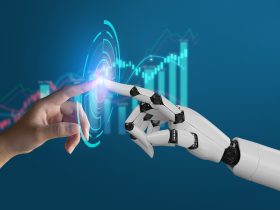Artificial intelligence (AI), which has altered how people work and interact with machines, has had a significant impact on the field of human resources (HR). The HR industry is no exception to the widespread changes brought on by AI in other sectors. AI is changing every facet of human resources, from hiring to employee engagement to talent management to HR analytics. In this article, we’ll discuss the benefits and drawbacks of artificial intelligence for the human resources sector. As AI spreads across industries, human resources (HR) has suffered significantly. Conversational AI, or chatbots, like ChatGPT, are one of the most recent developments in AI. These chatbots are revolutionizing the way companies communicate with potential employees, current workers, and human resources specialists.
Opportunity
Enhanced capacity to recruit
Automating steps like resume screening, preliminary interviews, and job performance predictions can all be achieved with the help of AI-powered recruitment solutions. Human resources departments can free up a lot of time and energy as a result of this. The use of an applicant tracking system (ATS) is critical to the success of any recruitment effort since it streamlines and improves the hiring process, aids in the identification of the best possible prospects, and supplies essential analytics and data.
Save money
usinesses that have implemented ChatGPT have claimed considerable cost savings, with 48% of respondents reporting savings of over $50,000 and 11% reporting savings of over $100,000, according to a recent study in Fortune. This information comes from a poll of 1,000 business leaders done by ResumeBuilder.com to determine their current and future interest in implementing ChatGPT. Coding, content development, copywriting, customer service, and meeting summaries are just some of the uses for ChatGPT in the business world.
The poll also found that over half of these businesses had already installed chatbots, with nearly half of those reporting that ChatGPT had successfully converted staff. Based on these findings, it appears that ChatGPT is not only a useful tool for encouraging employee engagement and adoption but also a cost-effective one.
Improved employee participation
Employee engagement and output can be boosted with the help of AI-powered chatbots and virtual assistants by giving workers instantaneous, individualized solutions to their questions. Human resources departments can also benefit from these tools since they make it easier to see where workers may need further
Management of talent that is streamlined
High-potential workers may be found, nurtured, and placed in the best possible jobs with the assistance of AI-powered talent management solutions. This can help businesses keep their best employees and cut down on turnover. New hires can get information about the company’s policies, procedures, and benefits from chatbots. This can make it easier for human resources personnel and give new hires a head start on their jobs.
Workforce planning and analysis
AI can examine sizable HR datasets to find patterns in employee performance, happiness, and productivity. These findings can equip HR departments with the information they need to make data-driven decisions that boost productivity.
HR processes
Tools powered by artificial intelligence are the best method to streamline a wide range of back-office operations, including payroll, benefits, time and expense tracking, invoicing, business travel, workflow design, and policy implementation.
Challenges
Discrimination and prejudice
If artificial intelligence systems are not built to be fair and inclusive or if they are trained on biased data, they can perpetuate existing prejudices and discrimination. Human resources departments must prioritize diversity, equity, and inclusion in the creation and rollout of AI solutions.
Confidentiality and safety
Human resources departments must guarantee the security of employee information and verify that AI systems are built to adhere to privacy laws. This involves making sure data is encrypted, that only authorized individuals can access it, and that workers are informed of how their information is being used.
Applying moral principles
Human resources departments must monitor the ethical and responsible usage of AI tools. It’s important to follow these guidelines so that AI isn’t misused in human resources and so that employees know how AI is being used and may ask questions about it.
Faulty Technology
Technical problems can cause chatbots to react incorrectly or not at all to a user’s inquiry. In order to verify that chatbots are providing accurate and helpful responses, HR personnel need to monitor them.
Computer Safeguards
Information such as a person’s employment history and contact details is collected and stored by chatbots. Human resources specialists are tasked with keeping this data safe and compliant with all applicable privacy laws.
Opposition from Workers
Some workers may be reluctant to use a chatbot and would rather have a conversation with a real person in HR instead. Human resources experts are responsible for implementing chatbots in a way that takes into account workers’ values and preferences.
Current Events
-
IBM
In February 2022, IBM announced the release of its new AI-powered human resources platform called “IBM My Career.” The platform employs AI to provide users with individualized recommendations for professional growth, job matching, and skill enhancement.
-
Accenture
Accenture’s New Report on AI in Human Resources: Its Benefits and Challenges Accenture, a consulting business, published research on the use of AI in human resources in January 2022, highlighting, among other things, the enhancement of recruitment, employee engagement, and performance management. The report did highlight certain obstacles, though, including the possibility of bias and ethical problems.
-
Amazon
With the launch of Alexa, the company’s digital voice assistant, Amazon has solidified its position as a leader in the field of artificial intelligence. This state-of-the-art technology is embedded in many areas of the company’s operations. Amazon’s use of AI is also notable because of the company’s propensity to foresee and meet the requirements of its customers. This is achieved by the collection of detailed information on each customer’s buying behavior, which gives the company the assurance to provide product recommendations and anticipate future needs through the application of predictive analytics.
The benefits and problems presented by the use of AI in HR are highlighted in these and other recent news pieces. While there are certainly advantages to using AI in the workplace, businesses should not overlook the need to address biases, ethical problems, and privacy issues before doing so.
The AI that sparked the uprising
The way that human resources managers communicate with job applicants and current workers may soon be drastically altered because of a new technology called ChatGPT. The use of chatbots has its drawbacks, but the advantages of enhancing the applicant experience, decreasing the workload of HR personnel, and increasing employee engagement are too great to ignore. Human resources personnel should think twice before implementing chatbots and should double-check that the bots are giving employees accurate and helpful responses that take into account their individual preferences and needs. ChatGPT has the potential to significantly improve the lives of HR professionals and businesses as a whole if it is implemented and monitored correctly. Over the past few years, AI has become increasingly popular across a wide range of businesses, and the HR sector is no exception. The need for more effective methods of human resource management has increased in tandem with technological developments.
The use of AI in HR departments is undergoing a dramatic transformation. The use of AI in human resources has the potential to greatly benefit enterprises. However, organizations also need to think about the difficulties of incorporating AI into human resources. Businesses may better exploit AI in HR and mitigate associated risks if they have a thorough understanding of the opportunities and difficulties presented by this technology. To successfully implement AI in HR, HR professionals and AI experts will need to work together to guarantee the technology is being used in a responsible and productive manner.
Many people, especially those working in industries like content writing, are concerned that the rise of AI and chatbots in the commercial world will result in job losses. Although artificial intelligence (AI) can automate some processes, it should be noted that such tools are meant to supplement human labor rather than replace it.
Artificial intelligence-powered chatbots like ChatGPT, which can automate tasks like answering frequently asked questions, setting up interviews, and even conducting preliminary candidate screenings, are becoming more and more common in human resources departments. This can free up a lot of time for HR departments, allowing them to concentrate on things like networking with potential new hires and improving their hiring practices.
It’s worth noting, though, that chatbots can’t take the place of real people just yet. They are capable of performing routine activities and answering basic queries, but they lack the emotional intelligence and creativity of humans, which are required for many positions in content creation and other creative professions.
Instead of eliminating jobs, several industry experts predict that AI and chatbots will open up new ones. As more companies adopt these technologies, there will be a greater demand for trained professionals who can create, deploy, and maintain them. Further, as AI develops, it will open up new opportunities for content writers and other creatives, allowing them to automate mundane activities so they can focus on more intricate, strategic endeavors.
However, it’s impossible to ignore the fact that AI and chatbots will affect the labor market. Some jobs may disappear or morph into something new as a result of technological advancements. However, it must be emphasized that these technologies are not meant to replace human laborers but rather to facilitate their productivity.
Conclusion
Despite worries that the advent of AI and chatbots may lead to a loss of jobs, the fact is that these tools were created to complement human labor, not replace it. New positions for skilled people will open up as organizations use these tools to boost productivity and performance. Businesses and employees alike must adapt to survive in a world increasingly dominated by artificial intelligence. HR departments face advantages and disadvantages when dealing with AI. Human resources departments may boost efficiency, productivity, and employee engagement by adopting AI-powered tools and strategies. They must also make sure AI is used in a fair and equitable way that takes into account issues of diversity and inclusion.

